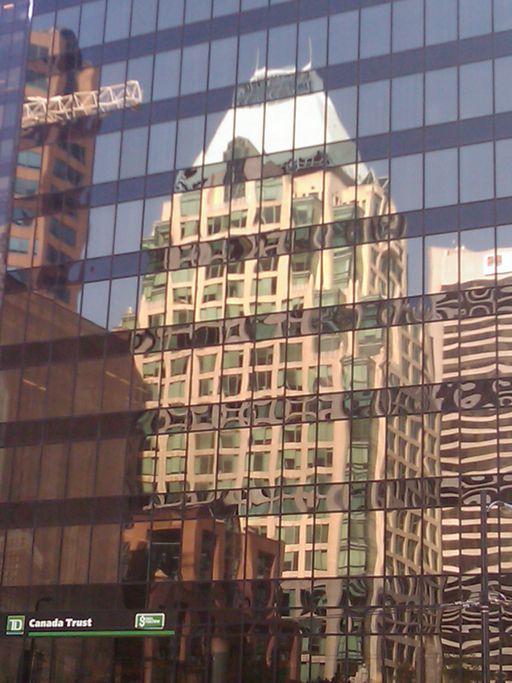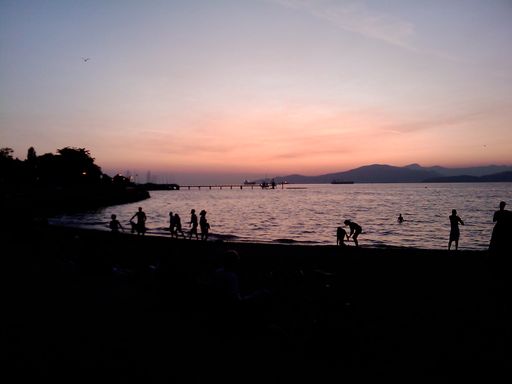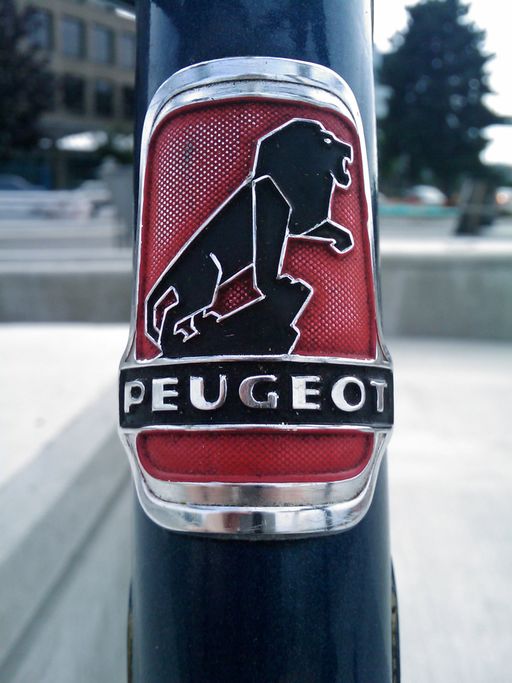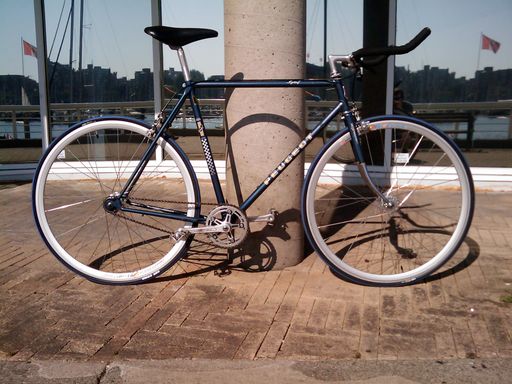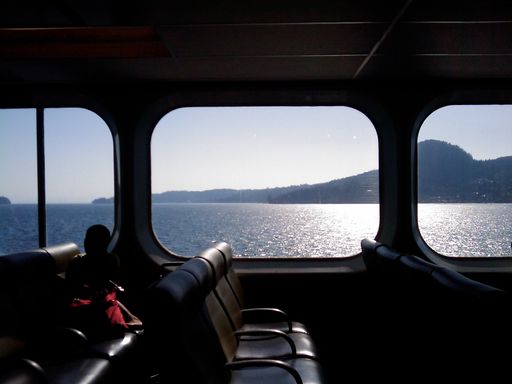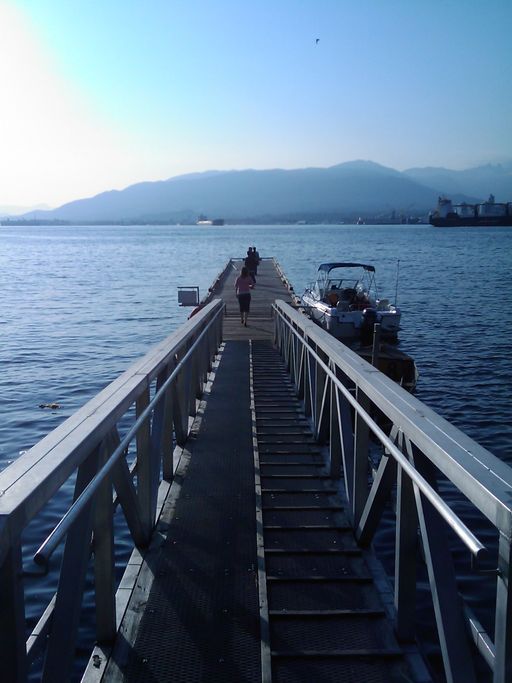In the summer of 2009, I flew from Heathrow to Vancouver, BC, to start a three-month secondment in a client’s office. The plane skimmed over the southern reaches of Iceland a few hours into the flight, passing over the crinkled grey-green relief map of the barren coastline, with icebergs dotting the sea off the still-frozen inlets and snow capping the spines of the land which framed them. The ice sheet was just visible as a horizon of whiteness off to the north.
Wow, I thought.
A few hours later we flew over the Canadian Rockies and I was agog once again. The peaks scrolled by under us, reaching a quarter or even a third of the way up to the 10-kilometre altitude of the plane, with dollops of creamy cloud settled in valleys and bowls two thousand metres up. The scale was incredible. I couldn’t imagine that the Himalayas would be any more hypnotic. Wow again, I thought.
Vancouver is a Big City: that’s how it seemed to me after a few days getting to know the place. It has distinct districts, where the architecture, the landscape and even the people form an indivisible, identifiable whole. There’s the downtown eastside, doubling as a low-rent Chinatown, where junkies and prostitutes wander the streets just blocks from the towers of the CBD; Yaletown, where glamourous urbanites flit from style bar to style bar in luxury SUVs; Commercial Drive, where the remnants of ’70s hippie culture mingle with the ironic stylings of the Vancouver hipster brigade; the West End’s gay village and high-rise condos, and so on. There’s a gridded street layout, 4-way stop signs, right turns on red, hotdog vendors, and all those other things which have been subconsciously implanted in your head by summer blockbusters and Tarantino pulp.
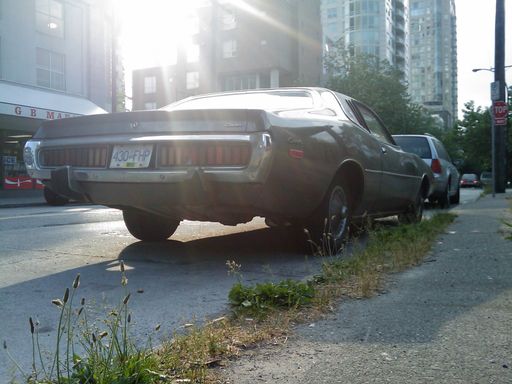
But LA this is not. There’s sprawl, sure, but it’s contained by water on three sides. There’s a high-rise downtown, but half of its modest peninsula is given over to leafy Stanley Park and the half that remains is closer in size to Chelsea than Manhattan. More than anything, Vancouver reminded me of Grand Theft Auto’s Liberty City, as if it had been constructed to distil the essence of a big North American city down to a size that would fit neatly in a games console’s memory – or a human’s. On past visits I’d dismissed the city exactly because of this: it was a twee pastiche of real North American cities, I had convinced myself, popular as a destination for film and TV productions precisely because it could be made to look like just about any of the “real” ones. On this trip, though, it seemed to me that maybe Vancouver was all of those other cities, lumped together in a peculiarly harmonious and Canadian way.
Driving north along Oak towards downtown, there comes a point when the road simultaneously straightens out and falls away towards False Creek, and when it does so, it opens up an astonishing view of the CBD’s tower blocks framed by the trees along the roadside and capped by the North Shore Mountains. Then, cycling round Stanley Park, the city disappears behind the trees and the view across Burrard Inlet reveals the mountains up close, with the yellow mounds of sulphur of North Vancouver’s port nestling beneath them. Above you is the suspended green strand of the Lions Gate Bridge, seeming too spindly to support the three lanes of traffic that pour in and out of the city at the start and end of each day.
The days were warm and bright and the sunsets were tinged with gold.
It was stunning.
Once settled in the apartment I hit Craiglist to find a bike on which I could attack the 26-kilometre round trip to the office, across False Creek and out through the ’burbs towards Richmond. A few phone calls landed me a 1982 Peugeot road bike so obscure that even the aptly-named retropeugeot.com made no mention of it. The seller arrived in a little Subaru hatchback festooned with racks bearing bikes in various states of repair. “I’m trying to make a business of it,” he explained as he pulled the Peugeot out from a further tangle inside. After a brief test ride, I bargained him down from $300 to $250, handed over the money and brought my prize up to the apartment to inspect. It seemed to be in perfect nick; according to the seller, its previous owner had been an old man who’d bought it new and left it in his garage for the intervening quarter century. I had in my hands a pristine piece of cycling history.
This history, unfortunately, like that of the French motor industry, is one of Gallic eccentricity in the face of bafflement from the rest of the world. Citroën’s cars, for example, have at various times sported such idiosyncrasies as wider seats in front and narrower seats in the back (why, for men and women respectively, of course), bouncy hydropneumatic suspension, and swivelling headlamps that turn to follow the front wheels. My Peugeot bike, on the other hand, looked normal but positively exploded with nonconformity as soon as I took a spanner to it. The wheels were a weird size. The handlebars were a weird diameter. The rear hub was a weird width. Every threaded part was threaded just fractionally differently from any and all accepted standards.1
But no matter: the bike went when I pedalled and it stopped, eventually, when I braked. Of course, this being the late noughties I was bound by law to replace its 2×5 drivetrain with a single chainring and cog, a process complicated at every turn by the bike’s innate Frenchness, but a week or two later it was finished and I was mobile at last. Vancouver’s surprisingly bike-friendly streets were that bit more accessible.
What better way to test a new bike, I thought, than some light civil disobedience? Single-speeded and messenger-bagged, on the last Friday in June I cycled towards Lions Gate Bridge.
“Where would I find Critical Mass?” I asked the 3,000-strong group of cyclists I found on the way there.
I joined the group as it meandered through Stanley Park and towards the bridge. All cycling life was here: commuters; messengers (and fakengers, like myself); roadies; mountain bikers; and even a pair of bicycle cops along for the ride. There was, to my surprise, a large number of people who looked as if they’d never ridden a bike before in their lives. They wobbled, they wove, they crashed. I couldn’t help but wonder if a quasi-anarchistic mob bent on retaking the streets was the best environment for a new cyclist, but more power to them for taking part all the same.

We cycled slowly but deliberately to the crest of the bridge, occupying first the permanent northbound lane, then the two-way central lane (signposted for southbound traffic), and finally the permanent southbound lane, eventually bringing the traffic to a halt. The few cars left on the bridge were trapped like insects in amber. (I furtively ogled a couple of sweet rides – a ’70s Ranchero and a convertible Mustang – immobilised with all the rest.) There were a few raised voices and some half-hearted honking of horns, but the majority of drivers were content to turn off their engines, wind down their windows and turn up the radio.
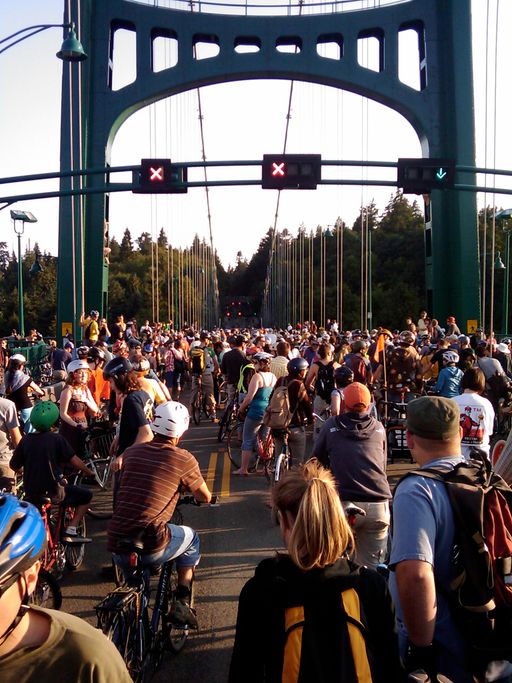
After forty-five minutes or so the general consensus seemed to be that it was time to get moving. We cycled southward off the bridge and back through Stanley Park, then along the waterfront of English Bay and over Burrard Bridge onto the mainland. As we went, some of the more experienced riders peeled off to “cork” side roads until the main group had passed and I, drunk with antiestablishmentarianism, did the same to some poor woman waiting to get out of her driveway.
“Thanks for waiting! We’ll just be a minute.”
Reader, it felt like hours. It takes a long time for three thousand cyclists to pass you by.
We swung along Broadway and turned back up Main, then cruised through the startling glumness of the downtown eastside before arriving back in the centre of town three hours and twenty-one kilometres after we had set off. I felt like I had finally arrived.
My next big ride, on the same sunny August day as Vancouver’s pride parade, turned into my longest yet. I threaded my way through the city as the crowd barriers were going up to meet some of the members of the Vancouver Bicycle Club on the far side of downtown. We headed through Stanley Park and up onto the Lions Gate Bridge, trying to make the most of the cool morning air.
On the downtown side, the bridge juts out from a lofty cliff and the ascent from there to the crest of the span is short and fairly innocuous. On the far side, though, you’re confronted with a steep, kilometre-long descent which disgorges you onto the shoulder of a busy freeway. We shot down it at ludicrous speed, the river two hundred feet below on the one side and 60 km/h traffic on the other, wheels thudding over the expansion joints and holding on for dear life. Having screwed the Peugeot together myself, I had absolutely no confidence that it was going to hold together. How would it fail, I wondered? Would the bars come off in my hands? Would a brake cable snap? It was an interesting time: tyres humming, wind roaring in my ears, outraged pedestrians backed into the barriers and every clenchable part of my anatomy at maximum clench.
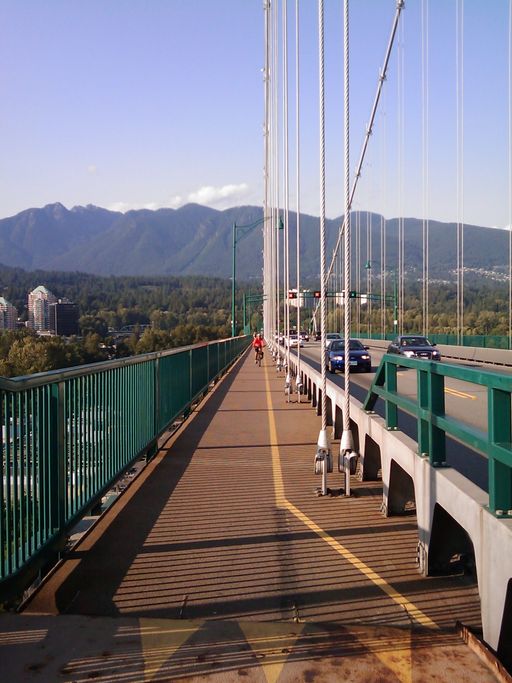
We whipped down onto the freeway shoulder intact, regrouped, and doubled back under the bridge onto the rolling coastal road to Horseshoe Bay.2 The sun gradually warmed things up, and I was sweating freely by the time we careered down an equally terrifying hill into Horseshoe Bay itself. The 40-minute ferry ride to Langdale over on BC’s Sunshine Coast let us decompress a bit, and we set off again at a more sensible pace once we arrived.
The Sunshine Coast is nice little place, a strip of leafy coastline northwest of Vancouver that conforms to my “all picturesque scenery must look like the Scottish Highlands” test of aesthetics. It’s part of mainland BC but the intervening terrain is too rugged for roads and so it’s accessible only by boat or floatplane. According to the guys on the ride, the inhabitants were mostly retirees, farmers, holidaymakers and a few demented Vancouver commuters. We stopped briefly in the town of Gibsons to refill our water bottles – it has a public well dispensing the one-time best drinking water in the world – and also so that I could have a brief, cathartic rant about the town’s appalling lack of an apostrophe.
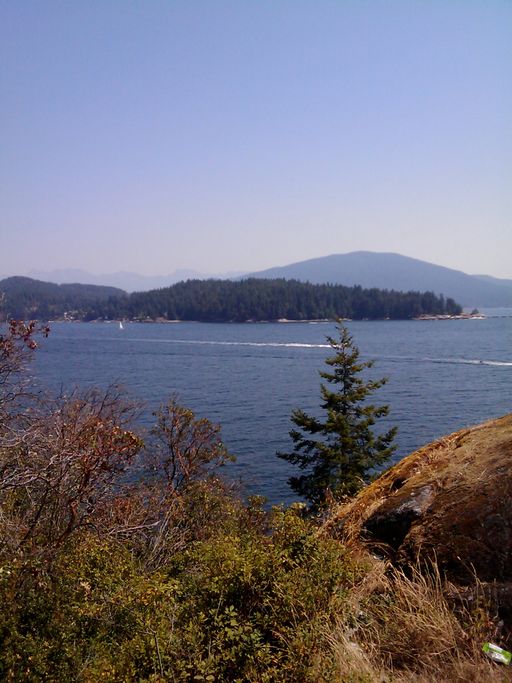
We stopped for lunch at a place called The Gumboot Café. The nearby town, Roberts Creek (Christ! Are apostrophes so difficult?), was once a staunch hippie hangout, and the smell of good old BC weed lingered in the air of the patio. We sank a couple of beers and headed home as the sun reached its peak, shaded at times by overhanging trees but otherwise sweating like bastards at each hill. I crawled into the apartment’s parking garage having done about 80 kilometres over the day, knackered from the exertion and sore from the bike. Thirty-year-old saddles don’t play.
Cycling’s an odd sport/hobby/pastime. Although everyone rides together, it’s difficult to chat much because of the need to stay in single file and the hills inevitably mean that the train gets broken up as the faster and slower riders spread out; then, everyone stops for a break and the pent-up chat just tumbles out. It manages to be competitive and cooperative, personal and social all at the same time. I kind of like it that way.
I’d met a guy called John at lunch in the office a few times. We’d chatted a bit about the Tour de France as it had been going on through August, and he’d mentioned that nearby Burnaby sported a fully enclosed velodrome. “I’ve been meaning to organise some beginners’ track lessons there, but we’ve always been one person short. Would you be interested?”
A thousand times yes, John.
I turned up at the track after work on Friday, parked the car and pushed through the revolving doors.3 The wooden track takes up the centre of the dome, leaving enough space at one side for changing rooms, offices and the like, but the corridor narrows down to barely a shoulder-width as it curves at the end. I followed voices along the curve under the eaves of the track, passing racks and racks of track bikes locked up under the banked corner, to find my colleagues Pete, Monica and John being fitted for their rental bikes. We were, it is fair to say, shitting ourselves.
Claire, our instructor for the evening, picked out a bike for each of us – shiny red fixed-gear Treks – and we wheeled them out through an underpass and into the centre of the track.
This was going to be scary.
The track is 200m long (too short for the Olympics, apparently) and is banked at 47° at each end. It’s the steepest track in North America, and if you don’t cycle at something like 30km/h around the corners then you fall off. It’s as simple as that. There were a few riders up there already, hurtling round and round to an astonishing cacophony of noises: tyres hummed over the lacquered wood and the track creaked and groaned as the riders flew over it.
Claire explained the markings on the track to us: the côte d’azur, or ‘on-ramp’ at the bottom; just above it, the metre-wide sprinter’s lane bordered by a pair of red and black lines, and the blue stayer’s line about halfway further up. It seemed impossibly distant. “That’s where you wait during the Madison,” she told us. “Don’t worry, we’ll get you up there — and a bit higher — before the end of the night.”
We had a few laps of the côte d’azur to get used to our brakeless, fixed-gear bikes. The rationale here is that if track bikes did have brakes, all it would take is one twitchy rider in the pack to brake suddenly and there would be a massive pile-up. The consequence is that slowing down is much, much harder; you have to let your legs continue to move with the pedals but apply a bit of pressure as they come up from bottom dead centre. It’s possible to just lock up your legs, but do it with enough determination and the still-rotating pedals will catapult you up and over the handlebars. I came close a couple of times.
After that we were encouraged up onto the banking along the straights, then back to the safety of the côte d’azur for the corners and eventually, once we had enough speed, up onto the banked track for the whole lap. The sensation is exhilarating, and mortifying. With ten or twelve beginners on the track, our speeds were all over the place: some riders were caning round as if to the velodrome born; others were creeping around with tyres squeaking in protest at the lack of speed in the corners. Claire had explained some track racing etiquette — call out “Stick!” as you approach someone to overtake, or let them know whether you’re passing them on the inside or outside, for example — and rounding a corner was terrifying mixture of wall-of-death speed and dodgem manoeuvering. “Stick!” I’d yell. “Jesus – STICK!” as some laggard ambled round in front of me, barely fast enough to keep from sliding off the track. All the while, more gung-ho riders shot by above us both with an airy whoosh and occasionally a whoop of glee.
We went on to experiment with pace lines, where a team of four cyclists circle the track in single file, the front rider each lap peeling off to the back of the pack. We yo-yo’d forward and back like a horizontal slinky: no brakes might prevent sudden stops but it doesn’t make it any easier to keep a constant speed. After that, Claire led the entire gaggle up to the top of the track for a flying 200 metres, where you hurtle down to the sprinter’s lane by the infield for a flying lap. These were exercising enough, but finally we moved onto Madison drills.
The Madison is a slightly bizarre race between teams of two riders: one rider rests above the blue stayer’s line, cycling slowly to conserve their energy, while the other races around the sprinter’s lane at the bottom. When the pair swap over, the racing rider transfers some of his momentum to his teammate by linking hands and slinging him forward. We weren’t going to try this (most of us were still astonished by every lap we managed to complete without injury or mishap), but we were going to get part of the way there. First, Claire told us, “You’re going to be riding with your hands in the drops. No using the flat bits on top. Take one hand off the bars on the straights, then put it back on for the corners. When you’re happy with that, try riding an entire lap with just one hand. Then do the same with the other.”
Okay, okay, we nodded.
“And then, you’re going to pair up. One rider is going to stay on the black line” — as in, the 2-inch-wide strip of black tape at the top of the metre-wide sprinter’s lane — “and the other has the whole of the sprinter’s lane to move around in. The second rider will stay slightly behind the first, and rest their right hand on the first rider’s back. For one whole lap.”
I know this doesn’t sound difficult. Reading it now, it sounds like a piece of cake. But on that track, where the illusion of a smooth surface at a distance was replaced by a rippling, creaking, tramlining mass of wooden boards, and where the 47° banking had you almost more horizontal than vertical in the turns, it seemed like an impossibility. The riders in each pair would have to speed up and slow down respectively in the corners to make up for the different radii of their turns; the outside rider had to quite literally toe the line with as little deviation as possible, and the inside rider had the awful task of making it round the track one-handed at 20 miles per hour just to avoid falling over by default.
Pete and I paired up and gingerly headed off. A few laps in I could complete a circuit one-handed, staring fixedly at the boards in front of me and pedalling like it was the only thing keeping me from smashing painfully into the blue paint of the côte d’azur, because that’s exactly what it was. A few laps after that I held to the black line as Pete steadied himself in the sprinter’s lane with his hand on my back, and a few laps after that we swapped over and managed a second paired lap, this time with me wobbling along below and slightly behind him, managing to keep my hand planted on his back for one complete lap. We had all the coordination, grace and assurance of newborn calves on an ice rink, but we did it. We came down to the infield sweating with nerves, and, if I remember rightly, actually high-fived each other without even a hint of irony. Claire congratulated us, and we were happy.
Three months after I had arrived, it was time to pack up and go home. I had one last night out with some of the guys from the office at an Italian restaurant called Campagnolo because, well, why not? Yes, it was close to the downtown eastside. And yes, the nearest place I could lock up my bike was the chicken wire around a vacant lot half a block away. And yes, this was a neighbourhood where the police received almost half as many more calls as the Vancouver average. But in the end, it was worth it. The food was plentiful and excellent, and the Peugeot was still there when we stumbled out onto the sidewalk. Sated, drunk and happy I said my goodbyes, wheeled the bike over to the seawall path, and cycled carefully home.
Since you asked: the bike was a Peugeot Sprint UO-12 with 27″ rather than 700c wheels, 25mm handlebars versus the more common 25.4 (a metric inch!), and an exceedingly odd rear hub width – 126mm, I thought at first, although my vernier caliper now claims 124, which is just bonkers. Who has ever used a 124mm hub? ↩︎
I have a memory that we, a pack of mostly lycra-clad cyclists, were heckled as “gay” by a gaggle of teenage skateboarders just outside Horseshoe Bay – on the same day as the pride parade, no less. Why not head into the city for your daily outburst of casual homophobia, I wondered? Far richer pickings there. At the time I flicked the V-sign; had it happened today I’d have stopped and yelled at them with foam-flecked lips. I have grown as a person. ↩︎
The pair of fire doors next to the main entrance had a big sign on them: “DO NOT OPEN BOTH DOORS AT ONCE!”. I asked Claire the instructor about this and she told me that the ’drome has an air-supported roof — it’s essentially a huge balloon which is kept rigid only by fans maintaining positive air pressure inside it. Unfortunately, air-supported domes have certain problems, like collapsing when it snows. ↩︎
